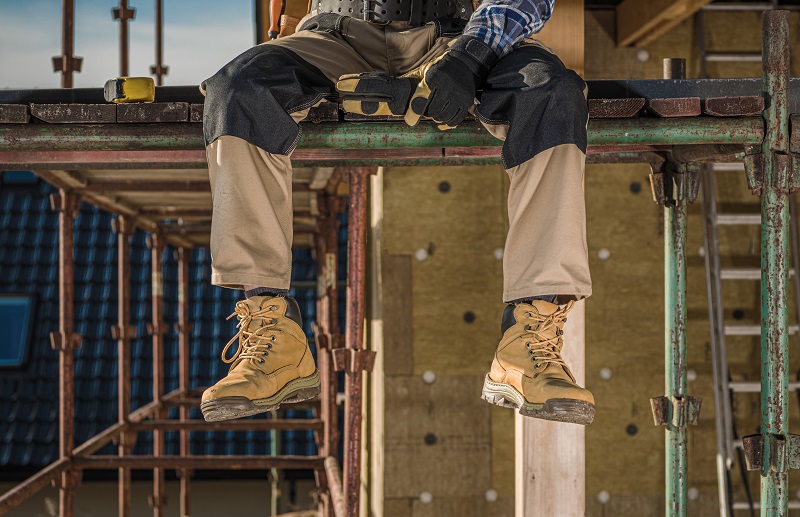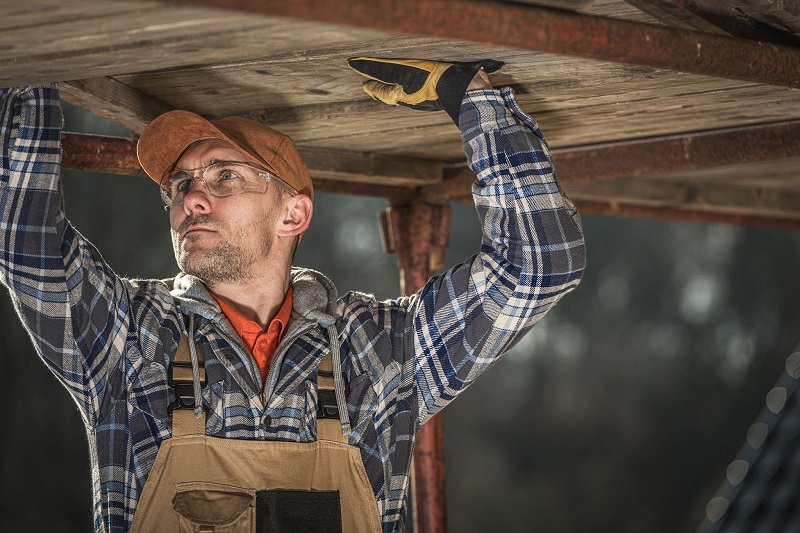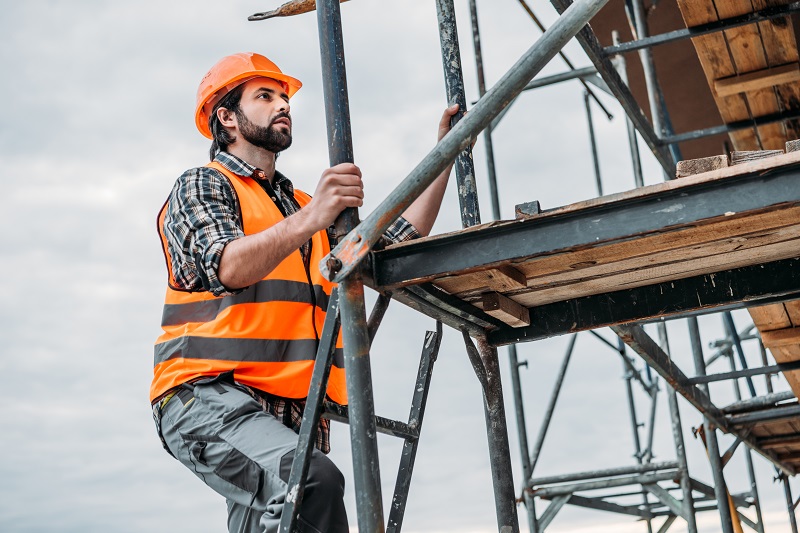There are various existing and predictable hazards associated with scaffolding, such as worker falls, falling objects and structure instability – therefore, OSHA scaffold regulations need to be enforced to ensure occupational safety and health.
In 2020, fall protection was the top cited OSHA violation, and scaffolding was the third-highest number of violations.
This shows how common and easy it is to overlook these things, and failure to meet OSHA standards of scaffolding requirements can result in fines and penalties if you undergo an inspection.
To ensure you’re OSHA compliant, here’s everything you need to know about the safety of scaffold systems in the workplace.
What Are Scaffold Maximum Intended Load Requirements?
Only a qualified person may design scaffolds. The scaffolding must then be constructed and loaded according to the design to provide fall protection.
Each scaffold component must be able to support its own weight and four times its maximum load weight.
Scaffold planks that make up the platform unit must be secured to the scaffold. The planks may only have a space between them of one inch or less and can be made from:
- solid sawn wood,
- fabricated planks, and
- fabricated flatforms.
The rigging of suspension scaffolds must be able to support at least six times the intended load.

What Are the Requirements for Supported Scaffolds?
Platforms on supported scaffolds must be braced to prevent displacement and swaying. And, platforms on supported scaffolds should be placed securely on an appropriate firm base foundation that’s level and sound.
To ensure stability for fall protection, scaffolds can be supported by:
- legs,
- outrigger beams,
- brackets,
- poles,
- uprights,
- posts,
- frames,
- or any other kind of rigid support.
Some other equipment, such as front-end loaders, have been specifically manufactured to support scaffold platforms.
Forklifts may be used as platform support when the whole platform is attached to the fork. During this time, the forklift shouldn’t move horizontally when employees are stationed on the scaffolding platform to ensure fall protection.
How Should Workers Access Scaffold Platforms?
Scaffold platforms that are more than two feet from an access point require structures to help workers get up or down.
These can be:
- portable ladders,
- hook-on ladders,
- attachable ladders,
- stair towers (scaffold stairways/towers),
- stairway-type ladders (like ladder stands),
- ramps,
- walkways,
- integral prefabricated scaffold access,
- direct access from another scaffold or structure, or a
- personnel hoist.
Take note that cross braces are not per OSHA standards and shouldn’t be used as a means of access as they don’t provide enough fall protection.

How Should Scaffolding and Scaffold Components Be Inspected and How Often?
Only a competent person may inspect scaffolds, supported scaffolds, suspended scaffolds and scaffold components.
A competent person is someone able to identify existing and predictable hazards which can be dangerous to workers. In addition, a competent person has the authority to take prompt corrective measures to eradicate any potentially dangerous situations for fall protection.
This should be done by a competent person:
- before each work shift begins, and
- if something happens that could result in a scaffold’s structural integrity being compromised.
The competent person should inspect each scaffold component for any visual defects that could weaken the structure.
If the competent person finds that the scaffolding has been damaged and won’t be able to carry the maximum required weight, it should be repaired, replaced or braced to do so. Should the competent person determine it cannot be fixed immediately, it must be removed from service operation.
What Are the Fall Protection Requirements?
According to OSHA scaffolding requirements, there are two main types of fall protection:
- guardrail fall protection systems, and
- personal fall arrest systems.
Guardrail systems must be installed along all sides of platforms to reduce fall hazards.
A personal fall arrest system can include:
- harnesses,
- components of the harness or belt-like dee-rings and snap hooks,
- lifelines, and
- the anchorage point.
Employers are responsible for providing fall protection for each worker on scaffolds more than ten feet above a lower level to prevent workers from falling to the lower level. Different types of scaffolding call for particular fall protection.
There should be at least one fall protection system to protect workers: if scaffolding doesn’t have guardrails, workers must have a personal fall arrest system if feasible.
Guardrail systems can also be used to protect workers below from falling objects. Other protection devices such as debris nets, catch platforms, canopy structures, or barricades may also be used for this purpose.
What Are the Training Requirements?
OSHA scaffolding requirements include training for two different types of workers:
- those who work on scaffolds, and
- those who erect and dismantle scaffolds.
Employees who work on scaffolds require training on:
- how to use the scaffold correctly,
- how to handle materials correctly on scaffolds,
- what the scaffold’s maximum intended load is,
- the nature of any potential electrical hazards, and
- fall protection and the correct use of the fall protection system.
Employees erecting or dismantling supported scaffolds require training on:
- how to erect, disassemble, move, operate, repair, inspect, and maintain the scaffolds,
- scaffold hazards, and
- what the scaffold’s maximum intended load is.

How Insure Compliance Can Help Employers
At Insure Compliance, we have developed a unique Safety Gap Model, which we use to assess the safety gaps within a company – in this case, regarding OSHA scaffolding regulations.
By performing this assessment, we can help the company address those gaps to reach OSHA compliance.
The safety gaps in a company can include:
- an awareness gap: the understanding of scaffolding regulations and what the company is required to do to ensure their safety,
- a process gap: documented policies and behaviors surrounding scaffolding,
- a knowledge gap: reinforcement of the implemented policies,
- a verification gap: observing the workplace, engaging with employees and inspecting behavior, and
- an accountability gap: holding employees accountable for behaviors not meeting the policies in place.
By bridging those gaps, the company has a much better chance of being confident of compliance during an OSHA inspection.
Key Takeaways
There are numerous things relating to scaffolds and scaffold components and structural integrity that companies in the construction industry need to know and address to be OSHA compliant and prevent scaffold accidents.
In anticipation of getting a job done, how workers get on and off the scaffolding, how the scaffolding is supported, and the requirements of maximum intended loads can easily be overlooked. That’s why OSHA has stipulated specific regulations, including providing fall protection.
OSHA states that different employees who work with scaffolding require different training and, as the employer, it’s your responsibility to ensure the appropriate training takes place.
An important part of this training is how scaffolding and scaffold components should be inspected by a competent person and other employees, how often, and how to take prompt corrective measures to ensure occupational safety and compliance.
If you need help or guidance reaching the OSHA scaffold regulations, contact us today. Our personalised approach to bridging your company’s safety gaps will save you time and save you money from receiving fines and penalties.
Disclaimer:
Please note that every effort has been made to ensure that the information provided in this guide is accurate. You should note, however, that the information is intended as a guide only, providing an overview of general information available to businesses. This guide is not intended to be an exhaustive source of information and should not be seen to constitute legal, safety or business advice. You should, where necessary, seek your own advice for any issues raised in your affairs.







